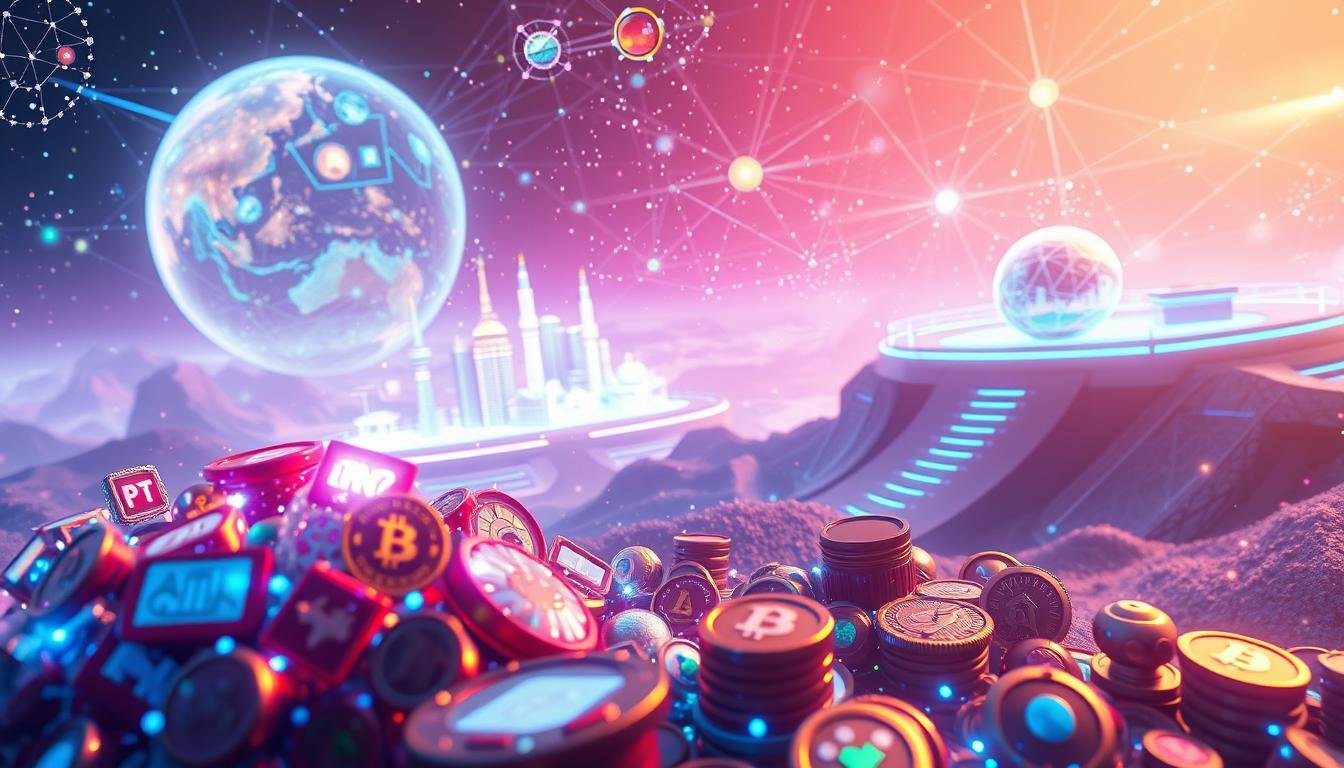The digital world has seen a groundbreaking concept emerge: non-fungible tokens. This innovation is changing how we view ownership and value in areas like art, music, and gaming.
NFTs, powered by blockchain technology, are creating new paths for creators to monetize their digital assets. They offer a secure and transparent method for buying, selling, and trading unique items.
This article will cover the basics of NFTs, their importance, and their vast possibilities. It aims to prepare you for a deeper dive into this exciting and rapidly evolving field.
Key Takeaways
- Understanding the concept of non-fungible tokens and their significance.
- Exploring the role of blockchain technology in NFTs.
- Discovering the potentials of NFTs in various industries.
- Learning about the benefits and opportunities NFTs provide.
- Gaining insights into the future of NFTs and their impact.
What Are NFTs and Why They Matter
Understanding NFTs is key to seeing the future of digital ownership. NFTs, or non-fungible tokens, are a big part of the digital economy. They offer a new way to show ownership of unique digital assets.
Defining Non-Fungible Tokens
Non-fungible tokens are digital assets that show you own something specific, like a piece of content. They use blockchain technology to verify this. Unlike other assets, NFTs are unique and can’t be swapped for something identical.
The Concept of Digital Uniqueness
NFTs are unique because they are digitally scarce. This makes each token special and valuable. It also changes how we think about digital replication and ownership.
Comparing NFTs to Cryptocurrencies
Cryptocurrencies like Bitcoin are fungible, meaning you can swap one for another. NFTs, on the other hand, are non-fungible. They represent unique digital assets that can’t be swapped for something identical. This shows why NFTs are valuable in the digital world.
The Value Proposition of Digital Scarcity
The value of NFTs comes from their digital scarcity. This is very valuable for digital art and collectibles. Blockchain technology makes sure ownership and provenance are secure. This makes NFTs appealing to collectors and investors.
Some key benefits of NFTs include:
- Uniqueness: Each NFT is distinct and cannot be replicated.
- Ownership: NFTs provide a clear record of ownership and provenance.
- Transferability: NFTs can be bought, sold, and traded on various platforms.
The Evolution of NFTs in the Digital Economy
The concept of NFTs has seen a significant transformation, marking a new era in the digital economy. NFTs, or Non-Fungible Tokens, have changed how we view ownership and scarcity in the digital world.
From CryptoKitties to Mainstream Adoption
The journey of NFTs started in the early 2010s. But it wasn’t until CryptoKitties launched in 2017 that they really caught attention. CryptoKitties was a trailblazer, showing the power of unique digital assets on the blockchain. It opened doors for NFTs in digital collectibles and more.
After CryptoKitties, interest in NFTs skyrocketed. New platforms and marketplaces sprang up, enabling the creation, sale, and trading of these unique assets.
Key Milestones in NFT Development
The evolution of NFTs has been marked by several key milestones. Some of the most significant include:
- The launch of NFT marketplaces like OpenSea and Rarible
- The integration of NFTs into mainstream culture, including collaborations with artists and celebrities
- The emergence of new use cases for NFTs, such as in gaming and virtual real estate
Breakthrough Moments in NFT History
Breakthrough moments in NFT history include record-breaking digital art sales and the launch of NFT-based gaming platforms. These moments have expanded NFT possibilities and attracted new participants to the marketplace.
Notable Record-Breaking Sales
NFTs have seen remarkable sales, with some digital art pieces fetching millions. These record-breaking sales have underscored the value of NFTs, boosting their popularity. The most notable sales have garnered significant media attention, further increasing NFT visibility.
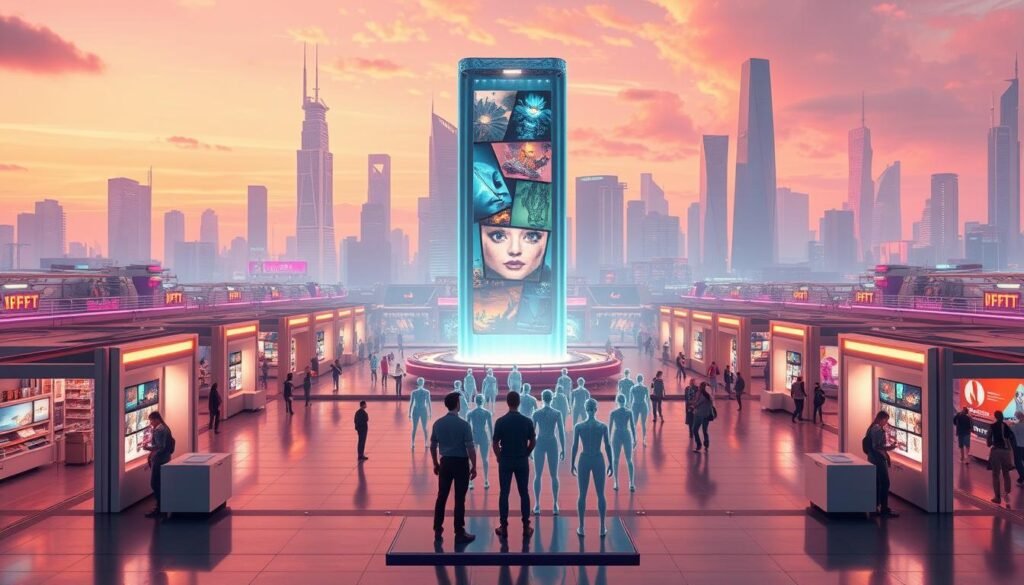
How NFTs Work: The Technical Foundation
To grasp NFTs, one must explore the blockchain technology that underpins them. NFTs, or Non-Fungible Tokens, redefine digital ownership and scarcity. They mark a new era in how we view and interact with digital assets.
Blockchain Technology Behind NFTs
The core of NFTs is blockchain technology. This decentralized ledger tracks transactions across a network of computers. It guarantees NFTs’ security, transparency, and resistance to tampering.
Ethereum and Other NFT Blockchains
Ethereum leads in NFT creation and trading, bolstered by its strong ecosystem and smart contract support. Yet, Binance Smart Chain, Flow, and Tezos are also making waves in the NFT arena.
The Minting Process Explained
Minting an NFT involves uploading a digital file to platforms like OpenSea or Rarible. It’s then transformed into a unique token on the blockchain. Smart contracts facilitate this, automating the verification and recording of ownership.
Smart Contracts and Token Standards
Smart contracts are vital in the NFT world. They enable the creation, sale, and transfer of NFTs. These contracts are programmed to enforce rules, like royalty payments to creators upon resale.
Understanding ERC-721 and ERC-1155
On Ethereum, ERC-721 and ERC-1155 are key token standards. ERC-721 allows for unique tokens, while ERC-1155 supports both fungible and non-fungible tokens. This versatility is a boon for developers.
Metadata and On-Chain vs. Off-Chain Storage
NFTs carry metadata that describes the digital asset. This metadata can be stored on-chain or off-chain. Each method has its pros and cons, affecting decentralization, accessibility, and cost.
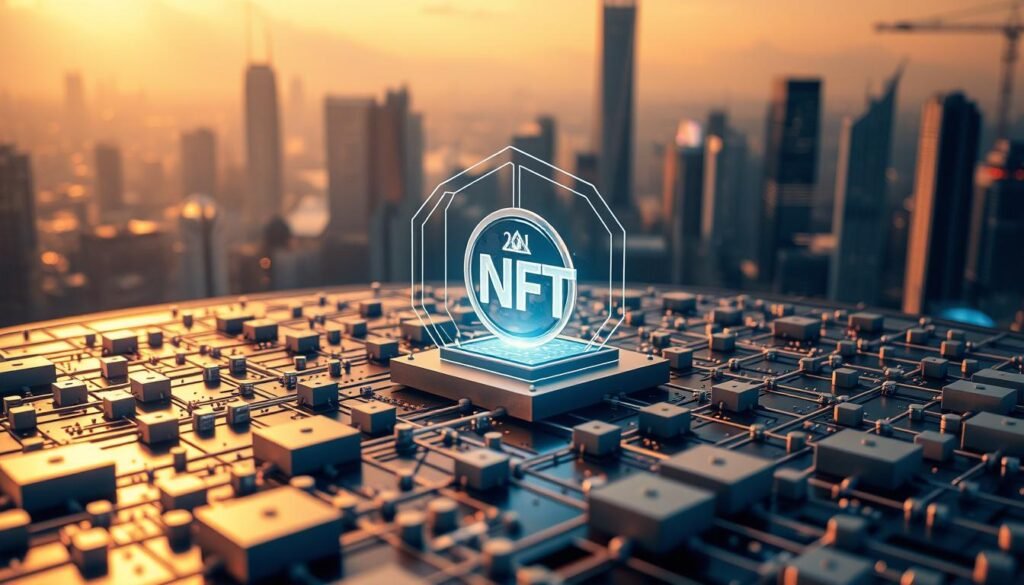
The technical underpinnings of NFTs are complex, involving blockchain, smart contracts, and token standards. As the NFT space grows, understanding these technologies is essential for creators and collectors alike.
The Current State of the NFT Marketplace
The NFT marketplace is rapidly evolving, with significant growth driven by major platforms and emerging trends. This landscape is constantly changing, presenting new opportunities and challenges.
Major NFT Platforms and Marketplaces
Several platforms support the NFT ecosystem, each with unique features and services. OpenSea, Rarible, and Foundation stand out as leading marketplaces.
OpenSea, Rarible, and Foundation
OpenSea is a leading marketplace, hosting a vast array of digital assets. Rarible focuses on community-driven creation and sales. Foundation supports artists by providing a platform for high-quality digital art.
Niche and Emerging Platforms
Beyond the major players, niche and emerging platforms cater to specific needs. These platforms specialize in particular digital assets or offer unique services.
Market Trends and Trading Volumes
The NFT market is marked by volatility and rapid growth. Understanding market trends and trading volumes is essential for collectors and investors.
Recent Sales Statistics and Growth Patterns
Recent data shows a significant rise in NFT trading volumes. This growth indicates ongoing interest in digital assets, with some NFTs commanding high prices.
| Platform | Trading Volume (Last 30 Days) | Number of NFTs Sold |
|---|---|---|
| OpenSea | $100 million | 50,000 |
| Rarible | $20 million | 10,000 |
| Foundation | $15 million | 5,000 |
Demographic Insights of NFT Collectors
NFT collectors span diverse backgrounds. The majority are aged 25-45, showing a strong interest in digital art and collectibles.
Exploring Popular Categories of NFTs
The realm of NFTs is vast, encompassing a multitude of digital assets. These digital assets have become integral to the digital economy, representing various forms of content and ownership.
Digital Art and Collectibles
Digital art and collectibles stand out as prominent NFT categories. NFT art has transformed the art world, providing artists with a new avenue for revenue. Digital collectibles, on the other hand, are unique digital items that can be traded and sold.
Profile Picture Projects and Generative Art
Profile picture projects, like CryptoPunks, have seen a surge in popularity. These projects feature unique digital characters for use as profile pictures. Generative art, employing algorithms, creates unique digital art pieces.
One-of-One Artworks and Collections
One-of-one artworks are singular digital creations by artists. Platforms like Rarible enable artists to curate and sell their collections to collectors.
Gaming and Virtual Real Estate
Gaming NFTs have become increasingly popular, with many games integrating gaming NFTs as in-game assets. Virtual real estate is also emerging, with platforms like Decentraland allowing users to buy and sell virtual land.
In-Game Assets and Play-to-Earn Models
In-game assets, such as characters and skins, can be traded using NFTs. Play-to-earn models enable players to earn cryptocurrency by playing games and selling their assets.
Metaverse Land and Virtual Properties
Metaverse land and virtual properties are gaining value, with users buying and selling virtual real estate. Platforms like The Sandbox and Decentraland are at the forefront of this trend.
Music, Sports, and Entertainment NFTs
NFTs are also being used in the music, sports, and entertainment sectors. Artists and athletes leverage NFTs to create unique digital content and engage with fans.
| Category | Description | Examples |
|---|---|---|
| Digital Art | Unique digital art pieces | CryptoPunks, Generative Art |
| Gaming NFTs | In-game assets and virtual items | Axie Infinity, Decentraland |
| Virtual Real Estate | Virtual land and properties | The Sandbox, Decentraland |
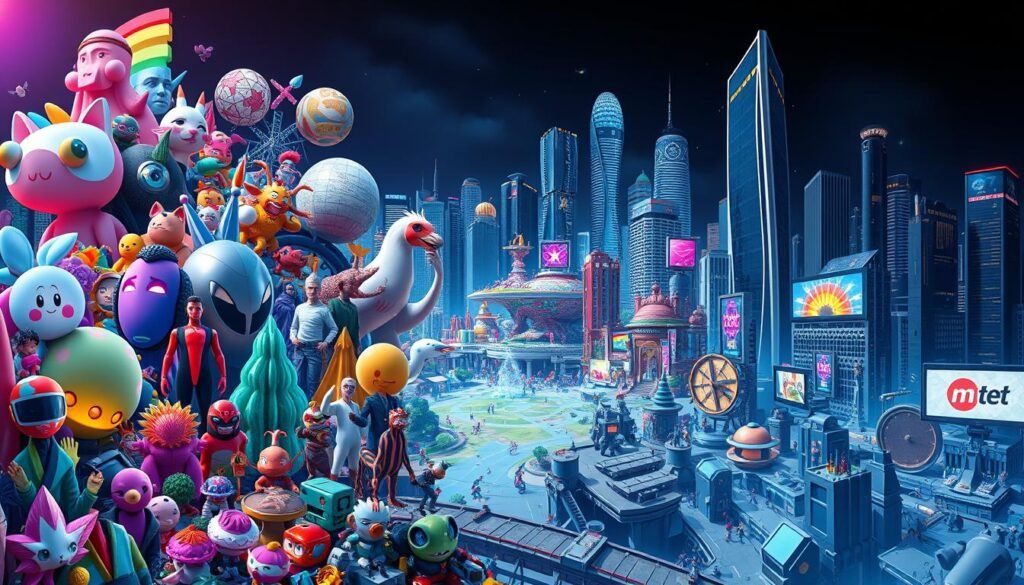
The Impact of NFTs on Creative Industries
NFTs are revolutionizing the creative world, opening new paths for artists and creators to monetize their work and engage with their audience. This transformation is reshaping the way art is produced and consumed. It’s also creating new income streams for creatives.
New Revenue Streams for Artists and Creators
The NFT market has empowered artists to connect directly with their fans, fostering a more personal and rewarding bond. This direct link enables direct-to-fan sales, allowing artists to sell their creations without intermediaries. This can potentially boost their earnings.
Direct-to-Fan Sales and Community Building
Artists can now create exclusive content for their fans using NFTs, building a dedicated community around their work. This approach not only increases fan engagement but also introduces a new revenue source through the sale of unique digital assets.
Eliminating Traditional Intermediaries
NFTs empower artists to circumvent traditional gatekeepers like galleries and auction houses, giving them greater control over their work and its pricing. This disintermediation can significantly increase creators’ profit margins.
Transforming Ownership and Royalty Models
NFTs are also transforming how ownership and royalties are managed in the creative industries. Smart contracts ensure creators receive fair compensation for their work, even in secondary markets.
Secondary Market Royalties
One key benefit of NFTs is the ability to earn royalties on secondary sales. This feature guarantees artists continue to benefit from their work even after it’s sold, providing a steady long-term income stream.
Fractional Ownership Possibilities
NFTs also enable fractional ownership, allowing multiple individuals to own parts of a digital asset. This model makes high-value art more accessible, democratizing ownership.
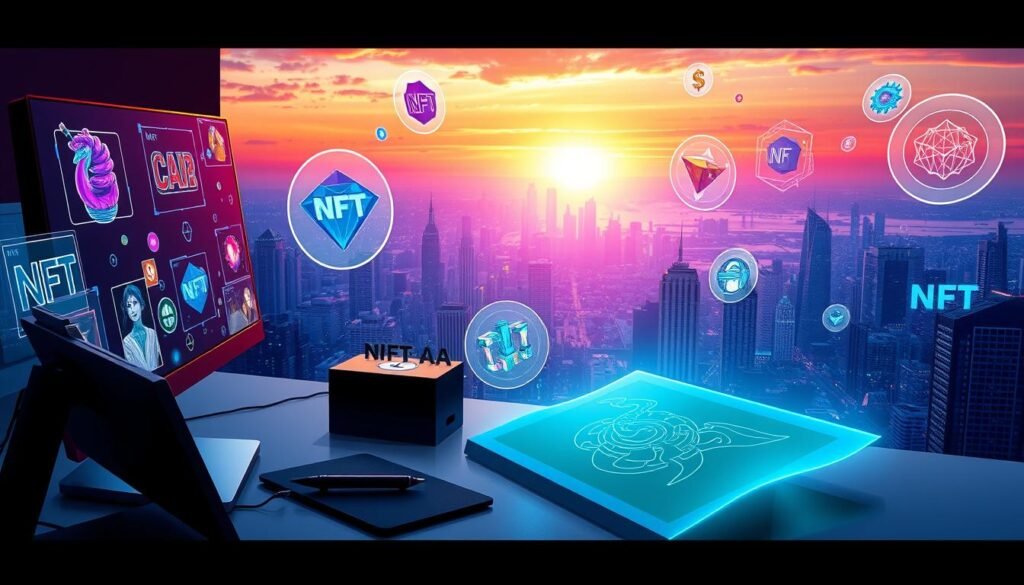
| Impact Area | Description | Benefit |
|---|---|---|
| Direct-to-Fan Sales | Artists sell NFTs directly to fans | Increased earnings for artists |
| Secondary Market Royalties | Royalties earned on resold NFTs | Ongoing revenue for creators |
| Fractional Ownership | Multiple owners of a single NFT | Democratized access to art |
Challenges and Controversies in the NFT Space
The NFT market, despite its growing popularity, is not without its challenges and controversies. As it evolves, it must address several pressing issues to ensure its sustainability. These challenges are critical for the market’s long-term viability.
Environmental Concerns and Energy Consumption
The environmental impact of NFTs is a major controversy. The creation, buying, and selling of NFTs consume a lot of energy, mainly due to blockchain technology. This has sparked concerns about the carbon footprint of NFTs, making them unsustainable.
“The environmental impact of NFTs is a pressing concern that needs to be addressed through innovative solutions and sustainable practices.”
Copyright Issues and Intellectual Property Rights
NFTs raise complex questions about copyright and intellectual property rights. They can represent ownership of digital art, music, and other creative works. This raises the risk of copyright infringement. It’s essential for creators and buyers to understand and respect these rights.
Market Volatility and Investment Risks
The NFT market is known for its volatility, with prices changing rapidly. This volatility poses significant risks for investors.
Speculative Bubbles and Price Fluctuations
Some argue that the NFT market is prone to speculative bubbles. These bubbles occur when prices are driven by hype, not intrinsic value. When these bubbles burst, prices can drop sharply, leading to substantial losses for investors.
Due Diligence for NFT Buyers
To manage these risks, NFT buyers must conduct thorough due diligence. This involves researching the creator’s reputation, understanding the sale terms, and staying informed about market trends.
| Risk Factor | Description | Mitigation Strategy |
|---|---|---|
| Speculative Bubbles | Prices driven by hype, not value | Research market trends and creator reputation |
| Copyright Issues | Potential infringement of intellectual property rights | Verify ownership and rights before purchase |
| Environmental Impact | High energy consumption associated with NFTs | Look for NFTs created on eco-friendly blockchains |
The Future of NFTs Beyond Art
NFTs are not just for art; they hold immense promise in many sectors. As the technology advances, we’ll see NFTs used in groundbreaking ways across industries.
NFTs in Decentralized Finance (DeFi)
NFTs are making waves in decentralized finance (DeFi). They can symbolize unique financial tools, like loans or insurance, opening up new avenues for financial products. This integration boosts DeFi’s liquidity and variety.
Identity Verification and Documentation
NFTs are also being explored for identity verification and documentation. They can securely store identity documents or credentials. This has major implications for healthcare, finance, and government services.
Real-World Asset Tokenization
Tokenizing real-world assets is a highly promising NFT application. It involves turning physical or intangible assets into digital tokens.
Real Estate and Physical Collectibles
Real estate and collectibles are ideal for tokenization. NFTs can signify ownership, streamlining the transfer and verification of assets. This could enhance liquidity in markets that were previously stagnant.
Event Tickets and Membership Passes
NFTs can also represent event tickets and membership passes. They help combat counterfeiting and improve access management. This benefits event organizers and businesses with membership models by ensuring transparency and security.
Conclusion: Navigating the NFT Landscape
Navigating the NFT landscape demands a deep grasp of its complexities and subtleties. This article has delved into how NFTs have grown from their beginnings to their current role in the digital economy.
The NFT market has experienced remarkable growth, with new categories like digital art, gaming, and entertainment emerging. Successfully navigating this landscape hinges on keeping abreast of market trends and technological advancements.
“The future of NFTs is not just about art; it’s about creating a new paradigm for ownership and value in the digital world.”
A summary of the key points is provided in the following table:
| Aspect | Description |
|---|---|
| NFT Definition | Non-fungible tokens representing unique digital assets |
| Market Growth | Significant expansion across various categories |
| Future Potential | Beyond art, into DeFi, identity verification, and more |
In conclusion, grasping the NFT landscape is essential for those interested in this rapidly evolving technology. By remaining informed and adapting to new developments, individuals can navigate the opportunities and challenges presented by NFTs more effectively.
Sources
For further reading and research on NFTs, the following sources provide valuable insights and information.
- CoinDesk: What Are NFTs?
- The Block: What Are NFTs?
- Decrypt: Non-Fungible Tokens (NFTs)
These references offer a deeper understanding of the NFT ecosystem, its evolution, and its applications. Exploring these sources can help readers stay updated on the latest developments in the NFT space.
FAQ
What is an NFT, and how is it different from a cryptocurrency?
A non-fungible token (NFT) is a unique digital asset that represents ownership of a specific item. This can include art, music, or collectibles. Unlike cryptocurrencies, which are fungible and interchangeable, NFTs are distinct. They cannot be exchanged for another identical asset.
How do NFTs work, and what is the role of blockchain technology?
NFTs are built on blockchain technology. This technology provides a secure, decentralized, and transparent way to record ownership and provenance. The blockchain ensures that NFTs are unique, scarce, and tamper-proof.
What is the process of minting an NFT, and what are the costs involved?
Minting an NFT involves creating a digital asset and recording it on a blockchain. The costs include gas fees, which are payments made to validators on the blockchain network. Other platform fees are also involved.
What are some of the most popular categories of NFTs, and what are their characteristics?
Popular categories of NFTs include digital art, collectibles, gaming, and virtual real estate. These NFTs often have unique characteristics. Scarcity, rarity, and provenance contribute to their value.
How do NFTs impact the creative industries, and what new opportunities do they offer?
NFTs provide new revenue streams for artists and creators. They allow them to monetize their digital work and connect directly with their audience. NFTs also enable new ownership and royalty models, giving creators more control over their work.
What are some of the challenges and controversies surrounding NFTs, and how can buyers mitigate risks?
Challenges and controversies surrounding NFTs include environmental concerns, copyright issues, and market volatility. Buyers can mitigate risks by conducting due diligence. Research the creator and the NFT marketplace. Understand the terms and conditions of the sale.
What is the future of NFTs beyond art and collectibles?
NFTs have the future to be used in various applications. This includes decentralized finance (DeFi), identity verification, and real-world asset tokenization. These use cases could unlock new value and opportunities for NFT holders and creators.
How do I buy and store NFTs securely?
To buy and store NFTs securely, use reputable NFT marketplaces like OpenSea or Rarible. Store your NFTs in a secure digital wallet, such as MetaMask. It’s also essential to follow best practices for securing your wallet and protecting your private keys.
